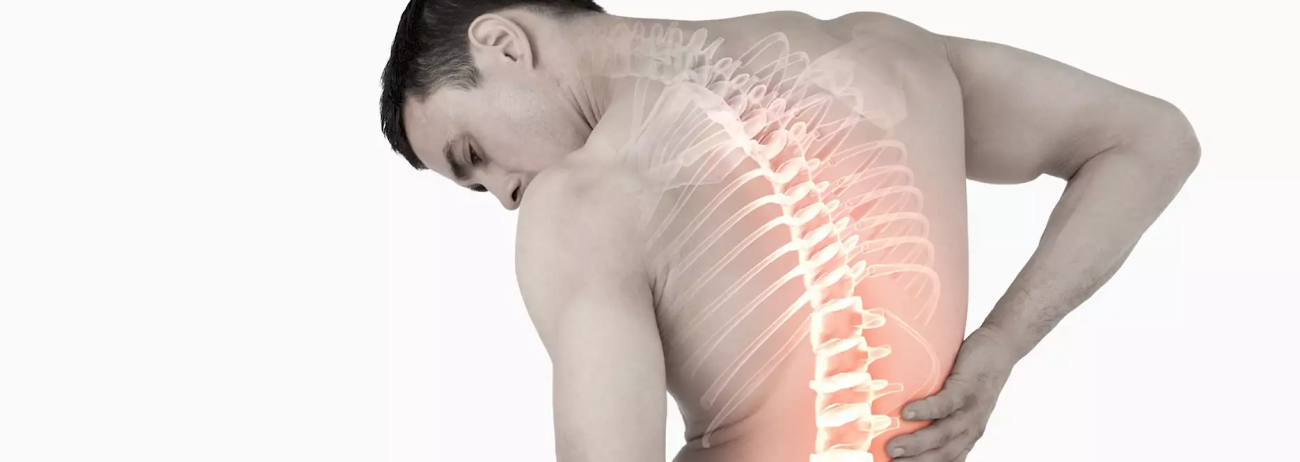Disc degeneration is the result of natural ageing of the intervertebral discs. It is a «normal» process.
Herniated discs, sometimes also called «disc prolapse», can be caused by:
|
For more information here.

The Clinica Ars Medica has a new centre of excellence with the aim of improving the quality of life of patients with pain related to spinal column disorders: Ars Medica Centro Colonna Vertebrale.
The Centre has two locations: the main one inside the prestigious Ambrosart complex in Manno and a branch in Muralto Locarno, inside Tertianum Residenza Al Parco.
The centre brings together various specialists in the different spinal column areas, who work in synergy with each other.
A team that puts the patient at the centre!
Disc degeneration is the result of natural ageing of the intervertebral discs. It is a «normal» process.
Herniated discs, sometimes also called «disc prolapse», can be caused by:
|
For more information here.
The intervertebral disc consists of a soft, elastic central part (nucleus pulposus) and a rigid, fibrous outer part (annulus fibrosus).
The deterioration and wear of the intervertebral disc generates discopathy, the levels of impairment of which are classified into four degrees of progressive severity: mild, moderate, severe, extra severe
The segments of the spinal column most susceptible to discopathy are the final stretch of the cervical spine between the fourth and seventh cervical vertebrae and especially the area between the third lumbar vertebra and the sacrum: that is, the points of our spine most subject to stress from movement.
The causes of lumbar and cervical discopathy are determined by the wear and tear of the disc in relation to the progression of the subject's age and thus in a certain way considered normal physiological ageing.
However, in some subjects this phenomenon occurs early and with particular severity and rapid evolution. The reasons for this are often related to excessive body weight, overwork, a sedentary lifestyle, an unbalanced diet low in fruit and vegetables, excessive use of alcohol, smoking, and prolonged competitive sports activities (football, tennis, cycling, rugby, running, horse-riding, for example) that place excessive strain and tension on the spine.
Sometimes constitutional factors may be at the origin (disc ring with particular intrinsic fragility), certain rheumatic diseases (rheumatoid arthritis) may be the cause.
The main manifestation symptom of a discopathy is pain in the neck or back.
Sometimes neck pain may be accompanied by arm pain (cervicobrachialgia), back pain may be accompanied by leg pain (lumbosciatica).
In the case of severe or severe discopathy, excessive impairment of the disc rings can lead to true deformities of the spinal column, with obvious damage and compression of nerve roots and spinal cord with serious neurological consequences: loss of strength and loss of sensation in the upper and lower limbs, with severe limitations in the functioning of the arms and legs.
An imbalance can cause chronic fatigue with wear on parts of the spinal column and altered statics.
Deformity, scoliosis and kyphosis being the most frequent, must be assessed already in childhood, but presents itself in most cases as a degenerative problem related to age.
age-related degenerative problem.
Read more here.
Spinal canal stenosis: narrowing with compression of the spinal cord and radiating pain in the legs, usually greater when walking.
Myelopathy: spinal cord disease often caused by chronic compression with arm-hand pain and severe static disorders, pain may be constant.
More information here.
Fractures in the context of osteoporosis.
Injury with fracture of one or more vertebrae.
For more information here.
Fractures in the context of osteoporosis.
Injury with fracture of one or more vertebrae.
For more information here.
Arthrosis surgery can cause problems adjacent to the operated segment or alterations in posture resulting in pain or compression of nerve structures.
For more information here.
Degenerative changes of the spine with a compressive effect can be treated with conservative or minimally invasive therapies for both therapeutic and diagnostic purposes.
For more information here.